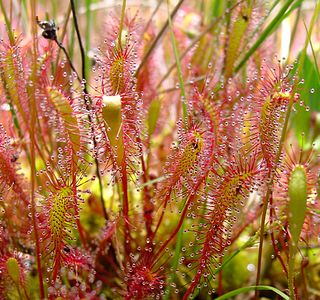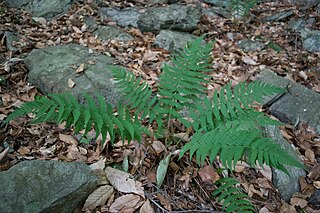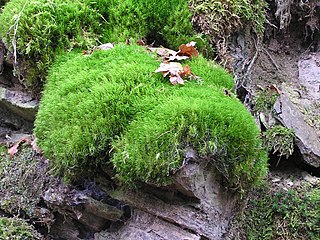
Drosera, which is commonly known as the sundews, is one of the largest genera of carnivorous plants, with at least 194 species. These members of the family Droseraceae lure, capture, and digest insects using stalked mucilaginous glands covering their leaf surfaces. The insects are used to supplement the poor mineral nutrition of the soil in which the plants grow. Various species, which vary greatly in size and form, are native to every continent except Antarctica.

Dryopteris, commonly called the wood ferns, male ferns, or buckler ferns, is a fern genus in the family Dryopteridaceae, subfamily Dryopteridoideae, according to the Pteridophyte Phylogeny Group classification of 2016 (PPG I). There are about 300-400 species in the genus. The species are distributed in Asia, the Americas, Europe, Africa, and the Pacific islands, with the highest diversity in eastern Asia. It is placed in the family Dryopteridaceae, subfamily Dryopteridoideae, according to the Pteridophyte Phylogeny Group classification of 2016 (PPG I). Many of the species have stout, slowly creeping rootstocks that form a crown, with a vase-like ring of fronds. The sori are round, with a peltate indusium. The stipes have prominent scales.

The Daintree Rainforest is a region on the northeast coast of Queensland, Australia, north of Mossman and Cairns. At around 1,200 square kilometres (460 sq mi), the Daintree is a part of the largest continuous area of tropical rainforest on the Australian continent. The Daintree Rainforest is a part of the Wet Tropics of Queensland Rainforest, that spans across the Cairns Region. The Wet Tropics Rainforest is the oldest continually surviving tropical rainforest in the world. Along the coastline north of the Daintree River, tropical forest grows right down to the edge of the sea.

Drosera rotundifolia, the round-leaved sundew, roundleaf sundew, or common sundew, is a carnivorous species of flowering plant that grows in bogs, marshes and fens. One of the most widespread sundew species, it has a circumboreal distribution, being found in all of northern Europe, much of Siberia, large parts of northern North America, Korea and Japan but is also found as far south as California, Mississippi and Alabama in the United States of America and in New Guinea.

Drosera anglica, commonly known as the English sundew or great sundew, is a carnivorous flowering plant species belonging to the sundew family Droseraceae. It is a temperate species with a circumboreal range, although it does occur as far south as Japan, southern Europe, and the island of Kauai in Hawaii, where it grows as a tropical sundew. It is thought to originate from an amphidiploid hybrid of D. rotundifolia and D. linearis, meaning that a sterile hybrid between these two species doubled its chromosomes to produce fertile progeny which stabilized into the current D. anglica.
The Portlethen Moss is an acidic bog nature reserve located to the west of the town of Portlethen, Aberdeenshire in Scotland. Like other mosses, this wetland area supports a variety of plant and animal species, even though it has been subject to certain development and agricultural degradation pressures. For example, the Great Crested Newt was found here prior to the expansion of the town of Portlethen. Many acid loving vegetative species occur in Portlethen Moss, and the habitat is monitored by the Scottish Wildlife Trust.

Dryopteris marginalis, vernacularly known as the marginal shield fern or marginal wood fern, is a perennial species of fern found in damp shady areas throughout eastern North America, from Texas to Minnesota and Newfoundland. It favors moderately acid to circumneutral soils in cooler areas but is fairly drought-resistant once established. In the warmer parts of its range, it is most likely to be found on north-facing non-calcareous rock faces. It is common in many altitudes throughout its range, from high ledges to rocky slopes and stream banks. Marginal wood fern's name derives from the fact that the sori are located on the margins, or edges of the leaflets.
Frond dimorphism refers to a difference in ferns between the fertile and sterile fronds. Since ferns, unlike flowering plants, bear spores on the leaf blade itself, this may affect the form of the frond itself. In some species of ferns, there is virtually no difference between the fertile and sterile fronds, such as in the genus Dryopteris, other than the mere presence of the sori, or fruit-dots, on the back of the fronds. Some other species, such as Polystichum acrostichoides, or some ferns of the genus Osmunda, feature dimorphism on a portion of the frond only. Others, such as some species of Blechnum and Woodwardia, have fertile fronds that are markedly taller than the sterile. Still others, such as Osmunda cinnamomea, or plants of the family Onocleaceae, have fertile fronds that are completely different from the sterile.

The Sifton Bog Environmentally Significant Area is a wetland jointly administered by the city of London, Ontario and the Upper Thames River Conservation Authority. It is located west of Hyde Park Road and south of Oxford Street inside the city limits of London, Southern Ontario, Canada. It is a Class 2 provincially significant wetland.

Prosartes hookeri is a North American species of flowering plants in the lily family known by the common names drops of gold and Hooker's fairy bells.

Dicranaceae is a family of haplolepideous mosses (Dicranidae) in class Bryopsida. Species within this family are dioicous. Genera in this family include Dicranum, Dicranoloma, and Mitrobryum.

Lysimachia asperulifolia is a rare species of flowering plant in the Primulaceae known by the common name rough-leaved loosestrife and roughleaf yellow loosestrife. It is endemic to the Atlantic coastal plain in North Carolina and northern South Carolina in the United States, where there are 64 known populations. It is a federally listed endangered species of the United States.
Briarwood Banks is the name given to a woodland Site of Special Scientific Interest (SSSI) in north Northumberland, North East England. Composed mainly of elm, oak and ash, the site is semi-natural and now recovering from the removal of planted conifers.